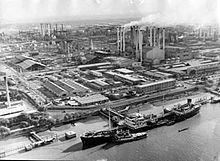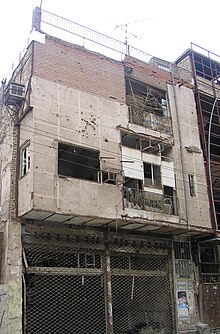Abadan
| Abadan | ||
|---|---|---|
| Abadan oil town, postcard from 1960 | ||
|
|
||
| Basic data | ||
| Country: |
|
|
| Province : | Chuzestan | |
| Coordinates : | 30 ° 20 ' N , 48 ° 18' E | |
| Height : | 3 m | |
| Residents : | 212,744 (2011) | |
| Time zone : | UTC +3: 30 | |
Abadan ( Persian آبادان Ābādān / ɔːbɔːˈdɔːn /) is a city on the Shatt el Arab in the province of Chuzestan in the extreme southwest of Iran . The city has almost 213,000 inhabitants. Abadan is home to one of the largest refineries in the world. It is the center of the Iranian oil industry .
geography
Abadan is about 50 km from the Persian Gulf on a 270 km² island of the same name. The Shatt el Arab in the west also forms the Iran- Iraq border. Abadan Island is about 68 kilometers long, 2 to 19 kilometers wide and is bounded in the east by Bahmanshir, an outflow of the Karun .
The city has an international airport and is home to a technological institute founded in 1939.
climate
The climatic conditions in Abadan are comparable to those of the Gulf States or Baghdad . In summer it is dry and hot in Abadan, with an average temperature of over 40 degrees during the day. Abadan reached its highest summer temperature on June 14, 2010 with 51 degrees. The old record was thus exceeded by 4 degrees; in June 1967 47 degrees had been measured in Abadan. In winter, on the other hand, there is mild, sometimes wet spring weather. Winter temperatures are around 16-20 degrees.
| Abadan | ||||||||||||||||||||||||||||||||||||||||||||||||
|---|---|---|---|---|---|---|---|---|---|---|---|---|---|---|---|---|---|---|---|---|---|---|---|---|---|---|---|---|---|---|---|---|---|---|---|---|---|---|---|---|---|---|---|---|---|---|---|---|
| Climate diagram | ||||||||||||||||||||||||||||||||||||||||||||||||
| ||||||||||||||||||||||||||||||||||||||||||||||||
|
Average monthly temperatures and rainfall for Abadan
Source: wetterkontor.de
|
|||||||||||||||||||||||||||||||||||||||||||||||||||||||||||||||||||||||||||||||||||||||||||||||||||||||||||||||||||||||||||||||||||||||
history
According to legend, Abadan was born by a man named Abbad b. Hosayn Kabeti established that during the governorship of Hajjaj one (695-714) Garrison is said to have built. The city was first mentioned by name around 864 by the geographer Ibn Chordadhbeh . During the Abbasid period, Abadan was a prosperous coastal town known for its salt and woven straw mats. The expansion of the Shatt-el-Arab Delta through mud deposits caused the coastline to gradually move away from the city. The Arab geographer Ibn Battuta described Abadan in the 14th century only as a small town with wide areas of salt.
The modern history of the city of Abadan is closely linked to the Iranian oil industry. In 1847 the Ottoman Empire ceded the city to Iran . On May 26, 1908, a well in Masjed Soleyman encountered oil at a distance of 360 meters. In April 1909 the concessionaires founded the Anglo-Persian Oil Company (APOC), which was supposed to extract, process and sell the oil they found. In order to be able to sell the oil, a pipeline, a refinery and a loading station for tankers first had to be built. The APOC chose the city of Abadan for this. The area was administered by Sheikh Khaz'al of Mohammerah. In 1909, after negotiations between the Persian Gulf Residency and Sheikh Khaz'al, an agreement was reached that provided for a payment of £ 650 per year for ten years, payable in advance. The Sheikh was also granted a loan of £ 10,000. It was also promised that the guards for the APOC facilities would be recruited from the tribe of the Sheikh. The first step in building up the Iranian oil industry was taken.
The first refinery and loading station was completed in 1913. Oil production began. When the First World War broke out , British troops landed in Abadan to secure the refinery. After the war, the refinery was continuously expanded and expanded until it was the largest refinery in the world in 1938.
During the Second World War , Abadan was an important transshipment port for supplies from the Allies to the Soviet Union under the Lending and Lease Act .
On August 19, 1978, the arson attack on the Cinema Rex cinema left 430 dead. Behind the attack were clergymen who wanted to harm the Shah regime. The city was partially destroyed in the First Gulf War from 1980. At the beginning of the war, hundreds of men and women in and around Abadan armed and resisted the advancing Iraqi troops before the Iranian army could intervene. A long siege followed , in the course of which large parts of Abadan were destroyed, including the oil refinery. An Iranian counterattack in 1982 ended the siege.
After the end of the First Gulf War in 1988, the oil industry in Abadan was slowly rebuilt and the port reopened in 1993.
City's culture and population
Abadan's population consists mainly of Iranian Arabs (around 60% of the population). For the most part, Shiite belief prevails . The colloquial language is derived from the so-called Khuzestani Arabic , a mixture of the Iraqi-Arabic dialect and the southwest Persian Bakhtiari dialect. The remaining 40% of the population are Persian-speaking ethnic groups such as Bakhtiars and Lurs . The majority of these were settled in Abadan after the end of the Iran-Iraq war.
Population development
| year | Residents |
|---|---|
| 1943 | 100,000 |
| 1956 | 226.083 |
| 1966 | 272,962 |
| 1976 | 294,068 |
| 1980 | 303,000 |
| 1986 | 0 |
| 1991 | 84,774 |
| 1996 | 206.073 |
| 2006 | 219.772 |
| 2011 | 212,744 |
Abadan's population growth was always closely linked to economic development and was among the highest when the refinery was expanded.
In 1943 there were 25,000 refinery workers out of a total population of 100,000. In 1948 the maximum was reached with 39,000 workers (about a third of the city's population). As a result of productivity increases, the workforce fell to 27,000 in 1956; at that time the city had 226,000 inhabitants according to the first official census . In the late 1950s, the population continued to grow through natural growth, and particularly through immigration . Abadan attracted most of the immigrants to Tehran who came from the rural West Zagros region and Kurdistan .
At the 1966 census, Abadan had a population of 276,000 with only 12,000 refinery workers and was now the fifth largest city in Iran. In 1980 the population reached its peak with an estimated 303,000 inhabitants. During the First Gulf War, Abadan was completely evacuated, so no more residents were registered in the 1986 census. After the war, many refugees returned to their homes and the population slowly rose to 84,774 in 1991. In 2011, 212,744 people lived in the city again.
See also
sons and daughters of the town
- Abie Nathan (1927–2008), Israeli pilot and peace activist
- Mardik Martin (1934–2019), American screenwriter of Armenian descent
- Hushang Golschiri (1937–2000), Iranian writer born in Isfahan and raised in Abadan
- Mehrdad Payandeh (* 1960), German trade unionist and doctorate in economics
- Bahman Golbarnezhad (1968-2016), physically disabled athlete
- Ebrahim Mirzapour (* 1978), soccer goalkeeper
- Patrik Baboumian (* 1979), Armenian strength athlete and bodybuilder
- Hossein Vafaei Ayouri (* 1994), professional snooker player
- Aghasi , singer
Web links
Individual evidence
- ↑ Thomas Brinkhoff: Ābādān (Khuzestan / خوزستان, Iran) - current population figures, population development, map and location. In: http://www.citypopulation.de . July 30, 2013, accessed May 7, 2014 .
- ↑ WetterOnline . Wetteronline.de. Retrieved July 3, 2010.
- ^ LP Elwell-Sutton: ĀBĀDĀN i. History . In: Encyclopaedia Iranica I / 1, May 2016, pp. 51–53.
- ↑ Ābādān . In: Encyclopædia Britannica .
- ↑ Zuhayr Mikdashi: A financial analysis of middle eastern oil concessions. 1901-65. Praeger, New York NY et al. 1966, p. 296.
- ↑ Mohammad Hossein Nejatian: ĀBĀDĀN iii. Basic Population Data . In: Encyclopaedia Iranica , 2014. (Table 1)
- ↑ a b c d X. de Planhol: ĀBĀDĀN ii. Modern Ābādān . In: Encyclopaedia Iranica I / 1, May 2016, pp. 53–57.
- ↑ Mohammad Hossein Nejatian: ĀBĀDĀN iii. Basic Population Data . In: Encyclopaedia Iranica , 2014.



